
3500PSI
Pressure Washer
Owner???s Manual
Questions? Help is just a moment away!
Contact the Local Snapper Service Center
Web: www.snapper.com or www.briggsandstratton.com
Model No.

3500PSI
Pressure Washer
Owner???s Manual
Questions? Help is just a moment away!
Contact the Local Snapper Service Center
Web: www.snapper.com or www.briggsandstratton.com
Model No.

Snapper 3500 PSI Pressure Washer
TABLE OF CONTENTS
Safety Rules. . . . . . . . . . . . . . . . . . . . . . . . . . . . . . . . . .
Know Your Pressure Washer . . . . . . . . . . . . . . . . . . . . . . 4
Assembly. . . . . . . . . . . . . . . . . . . . . . . . . . . . . . . . . . . .
Operation . . . . . . . . . . . . . . . . . . . . . . . . . . . . . . . . . .
Product Specifications. . . . . . . . . . . . . . . . . . . . . . . . . . . 11
Maintenance . . . . . . . . . . . . . . . . . . . . . . . . . . . . . . .
Storage . . . . . . . . . . . . . . . . . . . . . . . . . . . . . . . . . . . . . . 13
Notes. . . . . . . . . . . . . . . . . . . . . . . . . . . . . . . . 14, 22 & 23
Troubleshooting . . . . . . . . . . . . . . . . . . . . . . . . . . . . . . . 15
Replacement Parts. . . . . . . . . . . . . . . . . . . . . . . . . . .
Warranty . . . . . . . . . . . . . . . . . . . . . . . . . . . . . . . Last Page
EQUIPMENT
DESCRIPTION
Read this manual carefully and become familiar with your pressure washer. Know its applications, its limitations and any hazards involved.
Every effort has been made to ensure that information in this manual is accurate and current. However, Snapper reserves the right to change, alter or otherwise improve the product and this document at any time without prior notice.
 WARNING
WARNING 
The engine exhaust from this product contains chemicals known to the State of California to cause cancer, birth defects, or other reproductive harm.
In the State of California a spark arrester is required by law (Section 4442 of the California Public Resources Code). Other states may have similar laws. Federal laws apply on federal lands. If you equip the muffler with a spark arrester, it must be maintained in effective working order.
SAFETY RULES
The safety alert symbol ( ) is used with a signal word (DANGER, CAUTION, WARNING), a pictorial and/or a safety message to alert you to hazards. DANGER indicates a hazard which, if not avoided, will result in death or serious injury. WARNING indicates a hazard which, if not avoided, could result in death or serious injury. CAUTION indicates a hazard which, if not avoided, might result in minor or moderate injury. CAUTION, when used without the alert symbol, indicates a situation that could result in equipment damage. Follow safety messages to avoid or reduce the risk of injury or death.
) is used with a signal word (DANGER, CAUTION, WARNING), a pictorial and/or a safety message to alert you to hazards. DANGER indicates a hazard which, if not avoided, will result in death or serious injury. WARNING indicates a hazard which, if not avoided, could result in death or serious injury. CAUTION indicates a hazard which, if not avoided, might result in minor or moderate injury. CAUTION, when used without the alert symbol, indicates a situation that could result in equipment damage. Follow safety messages to avoid or reduce the risk of injury or death.
 WARNING
WARNING
Gasoline and its vapors are extremely flammable and explosive.
Fire or explosion can cause severe burns or death.
WHEN ADDING FUEL
???Turn pressure washer OFF and let it cool at least 2 minutes before removing gas cap.
???Fill fuel tank outdoors.
???Do not overfill tank. Allow space for fuel expansion.
???Keep gasoline away from sparks, open flames, pilot lights, heat, and other ignition sources.
???Do not light a cigarette or smoke.
WHEN OPERATING EQUIPMENT
???Do not tip engine or equipment at angle which causes gasoline to spill.
???Do not spray flammable liquids.
WHEN TRANSPORTING OR REPAIRING EQUIPMENT
???Transport/repair with fuel tank EMPTY or with fuel shutoff valve OFF.
WHEN STORING GASOLINE OR EQUIPMENT WITH
FUEL IN TANK
???Store away from furnaces, stoves, water heaters, clothes dryers or other appliances that have pilot light or other ignition source because they can ignite gasoline vapors.
 WARNING
WARNING
Spray contact with electrical wiring can result in electrocution.
???Keep water spray away from electric wiring or fatal electric shock may result.
 WARNING
WARNING
The high pressure stream of water that this equipment produces can pierce skin and its underlying tissues, leading to serious injury and possible amputation.
???Never aim the spray gun at people, animals or plants.
???Do not allow CHILDREN to operate the pressure washer.
???Never repair high pressure hose. Replace it.
2
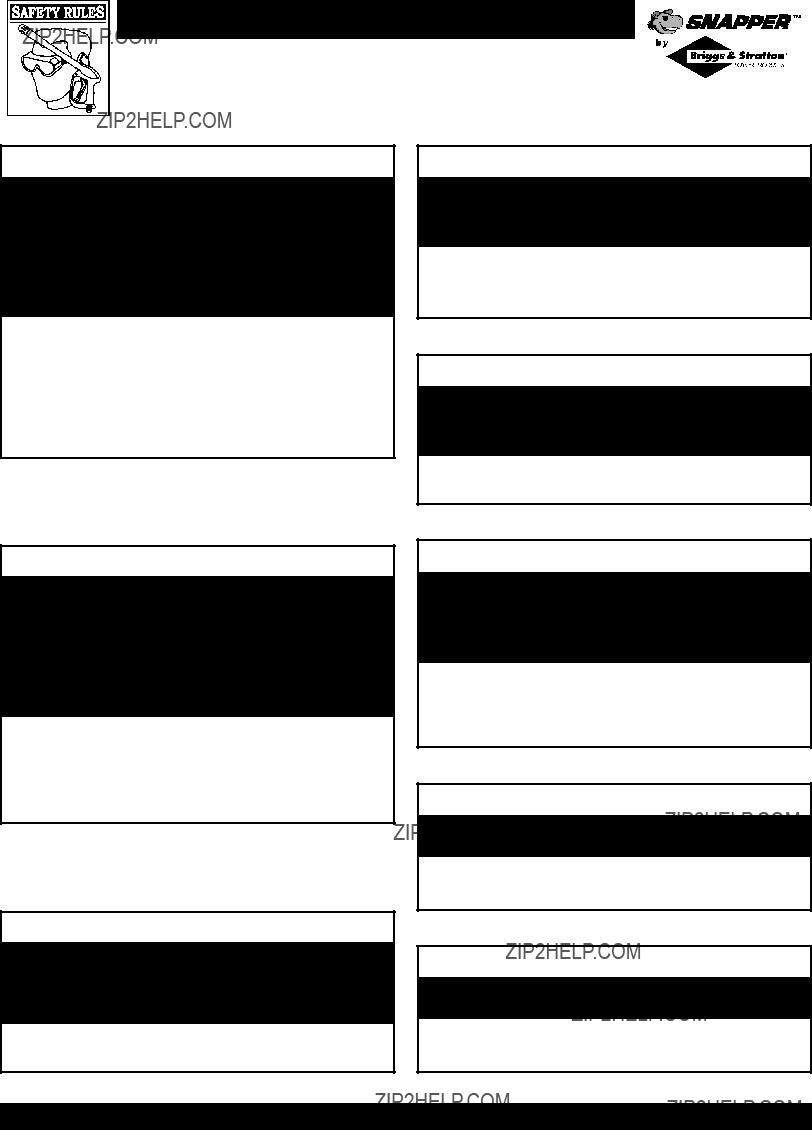
Snapper 3500 PSI Pressure Washer
 WARNING
WARNING
The high pressure spray could also cause you to fall if you are too close to the cleaning surface.
Pressure in a running washer builds as you climb. When you press the trigger, the recoil from the initial spray could cause you to fall.
 Use of pressure washer can create puddles and
Use of pressure washer can create puddles and  slippery surfaces.
slippery surfaces.
???Keep spray nozzle between 8 to 24 inches away from cleaning surface.
???Be extremely careful if you must use the pressure washer from a ladder, scaffolding or any other relatively unstable location.
???The cleaning area should have adequate slopes and drainage to reduce the possibility of a fall due to slippery surfaces.
???Operate this unit on a stable surface.
 WARNING
WARNING
Starter and other rotating parts can entangle hands, hair, clothing, or accessories.
???Do not wear loose clothing, jewelry or anything that may be caught in the starter or other rotating parts.
???Tie up long hair and remove jewelry.
 WARNING
WARNING
High pressure spray can cause paint chips or other particles to become airborne.
???Always wear eye protection when you use this equipment or when you are in the vicinity where the equipment is in use.
 DANGER
DANGER
Running engine gives off carbon monoxide, an odorless, colorless, poison gas.
Some chemicals or detergents may be harmful if inhaled or ingested, causing severe nausea, fainting or poisoning.
Breathing carbon monoxide will cause nausea, fainting or death.
???Operate pressure washer ONLY outdoors.
???Use a respirator or mask whenever there is a chance that vapors may be inhaled.
???Read all instructions with mask so you are certain the mask will provide the necessary protection against inhaling harmful vapors.
 WARNING
WARNING
Running engines produce heat. Temperature of muffler and nearby areas can reach or exceed 150??F (65??C).
Severe burns can occur on contact.
???Do not touch hot surfaces.
???Allow equipment to cool before touching.
 WARNING
WARNING
Unintentional sparking can result in fire or electric shock.
WHEN ADJUSTING OR MAKING REPAIRS TO YOUR
PRESSURE WASHER
???Disconnect the spark plug wire from the spark plug and place the wire where it cannot contact spark plug.
 CAUTION
CAUTION
Excessively high or low operating speeds increase risk of injury and damage to pressure washer.
???Do not tamper with governed speed.
???Do not operate the pressure washer above the rated pressure.
CAUTION
High pressure spray may damage fragile items including glass.
???Do not point spray gun at glass when in the jet spray mode.
???Never aim the spray gun at plants.
3

Snapper 3500 PSI Pressure Washer
KNOW YOUR PRESSURE WASHER
Read this owner???s manual and safety rules before operating your high pressure washer.
Compare the illustrations with your high pressure washer to familiarize yourself with the locations of various controls and adjustments. Save this manual for future reference.
Oil Fill Cap/Dipstick
Nozzle Extension with
Quick Connect
Pump equipped with
Automatic Cool Down System
Pressure
Control Knob
Chemical Injection Siphon/Filter
Air Filter ??? Protects engine by filtering dust and debris out of intake air.
Automatic Cool Down System ??? Cycles water through pump when water reaches
Chemical Injection Siphon/Filter ??? Use to siphon detergent or other pressure washer chemicals into the low pressure stream.
Choke Lever ??? Prepares a cold engine for starting.
Fuel Valve ??? Used to turn fuel on and off to engine.
Gas Tank ??? Fill tank with regular unleaded gasoline. Always leave room for fuel expansion.
High Pressure Hose ??? Connect one end to the water pump and the other end to the spray gun.
High Pressure Outlet with Quick Connect ??? To
connect high pressure hose.
Rocker Switch
Throttle Lever
Choke Lever
Fuel Valve
Recoil Starter (on front of engine)
High Pressure Hose
 Air Filter
Air Filter
High Pressure Outlet with Quick Connect
Water Inlet
Nozzle Extension with Quick Connect ??? Allows you to
switch between four different spray nozzles.
Oil Fill Cap/Dipstick ??? Fill engine with oil here.
Pressure Control Knob ??? Varies the pressure of the high pressure spray.
Pump ??? Develops high pressure.
Recoil Starter ??? Use for starting the engine manually.
Rocker Switch - Set this switch to "On" before using recoil starter. Set switch to "Off" to switch off engine.
Spray Gun ??? Controls the application of water onto cleaning surface with trigger device. Includes safety latch.
Spray Nozzles ??? Chemical injection, 0??, 15??, 25??, and 40??: for various cleaning applications.
Throttle
Water Inlet ??? Connect garden hose here.
4
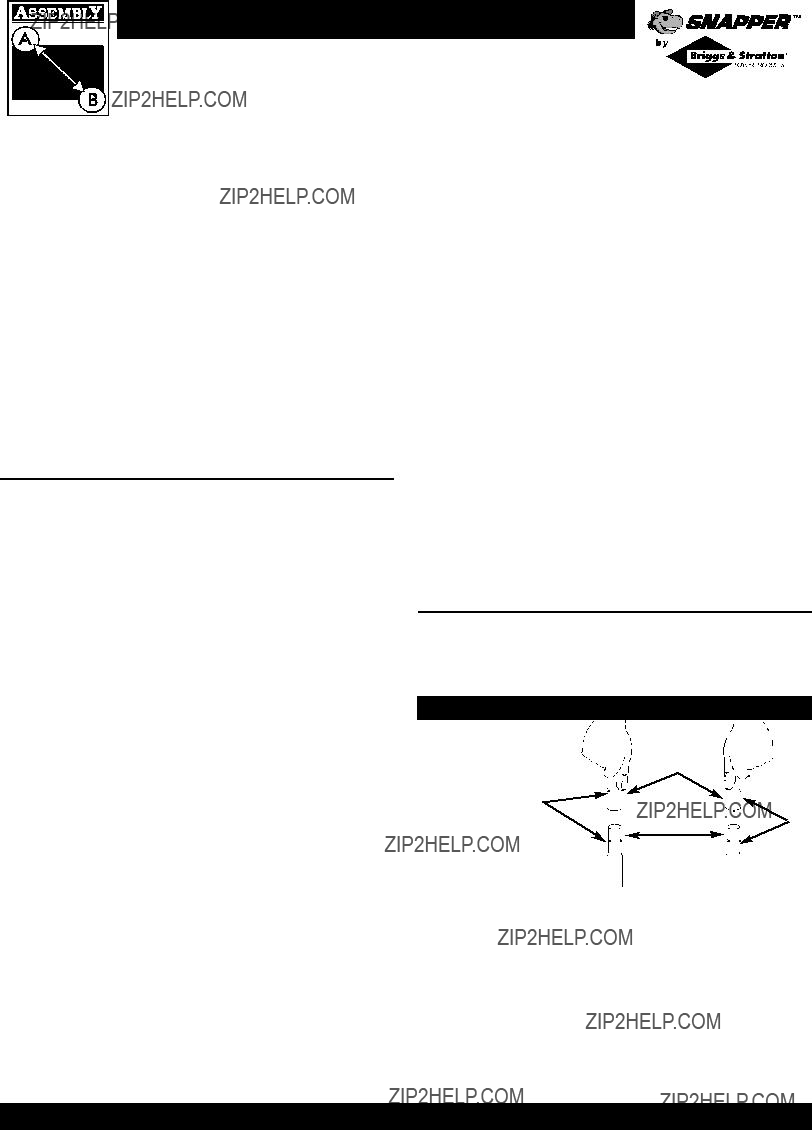
Snapper 3500 PSI Pressure Washer
IMPORTANT: Read entire owner???s manual before you PREPARING PRESSURE attempt to assemble or operate your new pressure washer.
REMOVE PRESSURE
WASHER FROM
CARTON
???Remove all accessories and parts bag included with pressure washer.
???Slice two corners at the end of carton from top to bottom so the panel can be folded down flat, then remove all packing material.
???Roll pressure washer out of carton.
Carton Contents
Items in the carton include:
???Main unit
???High pressure hose
???Handle
???Pump oil dipstick (hanging on pump)
???(2) bottles of engine oil
???Safety goggles
???Spray gun with quick connect fitting
???Nozzle extension with quick connect fitting
???Accessory bag (includes the following):
???Owner???s registration card
???Nozzle cleaning kit
???Bag containing 5
???
???Owner???s manual
???Engine manual
???Handle hardware, including one carriage bolt, one ???L??? bolt and 2 plastic knobs
If any of the above parts are missing or damaged, contact the local Snapper service center.
WASHER FOR USE
If you have any problems with the assembly of your pressure washer or if parts are missing or damaged, contact the local Snapper service center.
To prepare your pressure washer for operation, you will need to perform these tasks:
???Fill out and send in the registration card.
???Attach the handle to the main unit.
???Add oil to the engine.
???Add fuel to the fuel tank.
???Connect the high pressure hose to the spray gun and the pump.
???Connect the water supply to the pump.
???Connect nozzle extension to spray gun.
???Select and install desired nozzle.
Attach Handle to the Pressure Washer
???Place the handle onto the handle supports already connected to the main unit. Make sure the holes in the handle align with the holes on the handle supports. (Figure 1)
Figure 1 ??? Attach the Handle to the Base
NOTE: It may be necessary to move the handle supports from side to side in order to align the handle so it will slide over the handle supports.
???Insert the carriage bolt through the hole on the left side of the handle (viewing from rear of unit) and attach the plastic knob (Figure 2). Tighten the knob by hand.
5
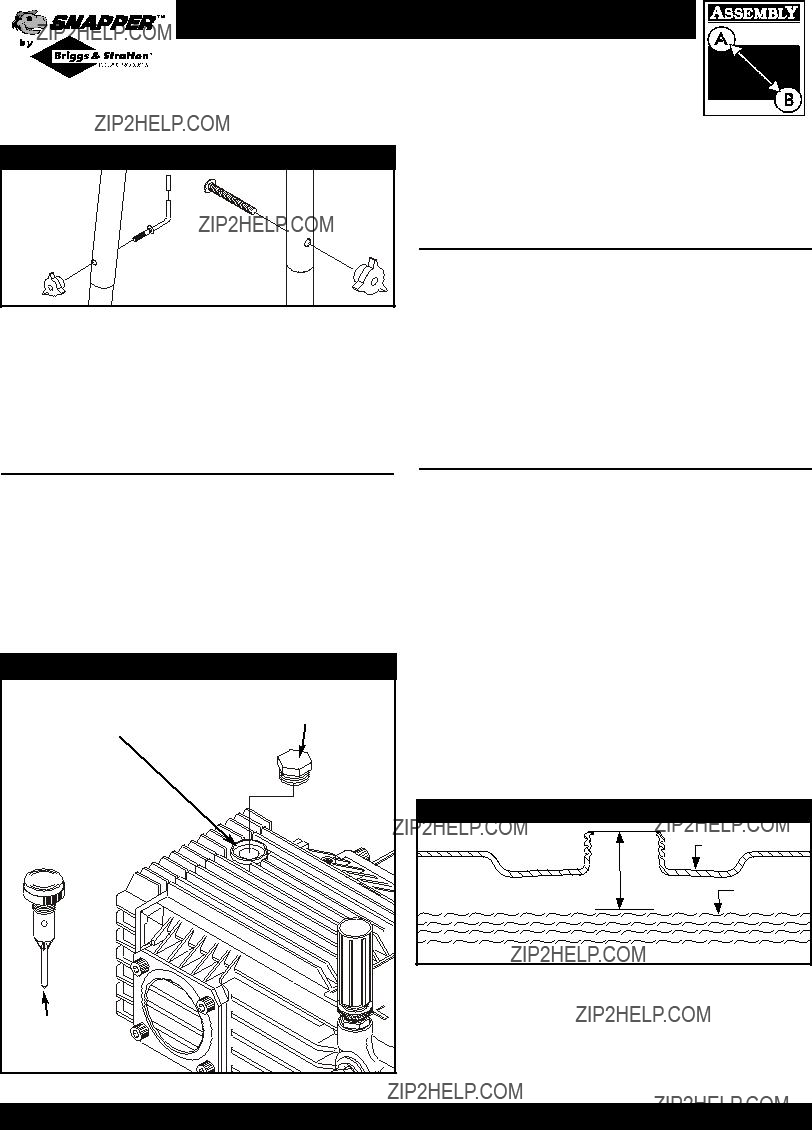
Snapper 3500 PSI Pressure Washer
???Insert the ???L??? bolt through the hole on the right side of the handle (viewing from rear of unit) and attach the plastic knob (Figure 2). Tighten the knob by hand. If not installed, add the vinyl cap to the ???L??? bolt.
???Insert the
??? Install the oil dipstick.
NOTE: The pump is
Add Engine Oil
IMPORTANT: Any attempt to crank or start the engine before it has been properly serviced with the recommended oil may result in an engine failure.
???Place pressure washer on a level surface.
???Refer to the engine owners manual to add recommended oil to engine.
NOTE: Check oil often during engine
Install Oil Dipstick on Pump
CAUTION! You MUST remove the pump???s shipping cap and install the oil dipstick. Failure to do so will void the warranty and damage the pump.
Add Gasoline
 WARNING! Never fill fuel tank indoors. Never fill fuel tank when engine is running or hot. Allow unit to cool for two minutes before refueling. Do Not light a cigarette or smoke when filling the fuel
WARNING! Never fill fuel tank indoors. Never fill fuel tank when engine is running or hot. Allow unit to cool for two minutes before refueling. Do Not light a cigarette or smoke when filling the fuel
To install the oil dipstick:
???Make sure your unit is on a level surface.
???Remove and discard the shipping cap located on the pump (Figure 3).
tank.
 WARNING! Do Not overfill the fuel tank. Always allow room for fuel expansion.
WARNING! Do Not overfill the fuel tank. Always allow room for fuel expansion.
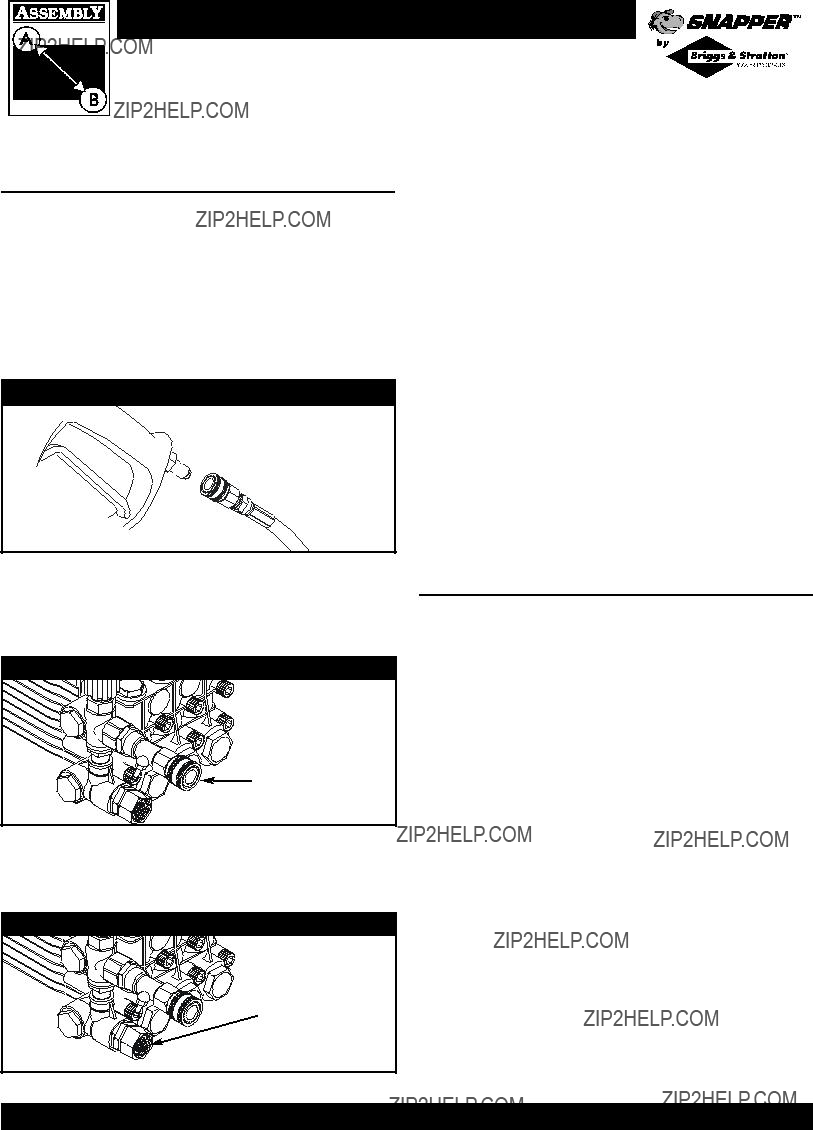
Snapper 3500 PSI Pressure Washer
Connect Hose and Water Supply to Pump
IMPORTANT: You must assemble the nozzle extension to the spray gun and attach all hoses before you start the engine. Starting engine without all hoses connected and water supplied will damage the pump.
???Uncoil high pressure hose and attach quick connect end of hose to the base of the spray gun (Figure 5). Pull down on the collar of the quick connect, slide onto the spray gun and let go of collar. Tug on hose to be sure of a tight connection.
Figure 5 ??? Connect High Pressure Hose to Spray Gun
Connect high pressure hose 
 here.
here.
???Similarly, attach the other end of the high pressure hose to the high pressure outlet on the pump (Figure 6). Pull down on the collar of the quick connect, slide onto the pump and let go of collar. Pull on hose to be sure of a tight connection.
Figure 6 ??? Connect High Pressure Hose to Pump
???Before you connect your garden hose to the water inlet, inspect the inlet screen (Figure 7). Clean the screen if it contains debris, replace if damaged. DO NOT RUN THE
PRESSURE WASHER IF THE SCREEN IS DAMAGED.
Figure 7 ??? Connect the Garden Hose to Water Inlet
???Run water through your garden hose for 30 seconds to clean out any debris. Turn off water.
IMPORTANT: Do Not siphon standing water for the water supply. Use ONLY cold water (less than 100??F).
???Connect the garden hose to the water inlet. Tighten by hand (Figure 7).
CAUTION! There MUST be at least ten feet of unrestricted garden hose between the pressure washer inlet and any flow shut off device, such as a ???Y???
???Turn ON the water.
???Squeeze the trigger on the spray gun until you have a steady stream of water. This purges the pump of air and impurities.
 CAUTION! Before starting the pressure washer, be sure you are wearing adequate eye protection.
CAUTION! Before starting the pressure washer, be sure you are wearing adequate eye protection.
Checklist Before Starting Engine
Review the unit???s assembly to confirm you have performed all of the following:
???Make sure the handle is secure.
???Check for properly tightened hose connections.
???Check to make sure that there are no kinks, cuts, or damage to the high pressure hose.
???Check that oil has been added to the proper level in the engine crankcase.
???Add the proper gasoline to fuel tank.
???Provide a proper water supply (not to exceed 100??F) at a minimum flow of 3.9 gallons per minute.
???Be sure to read ???Safety Rules??? and ???How To Use Your Pressure Washer??? before using the pressure washer.
7
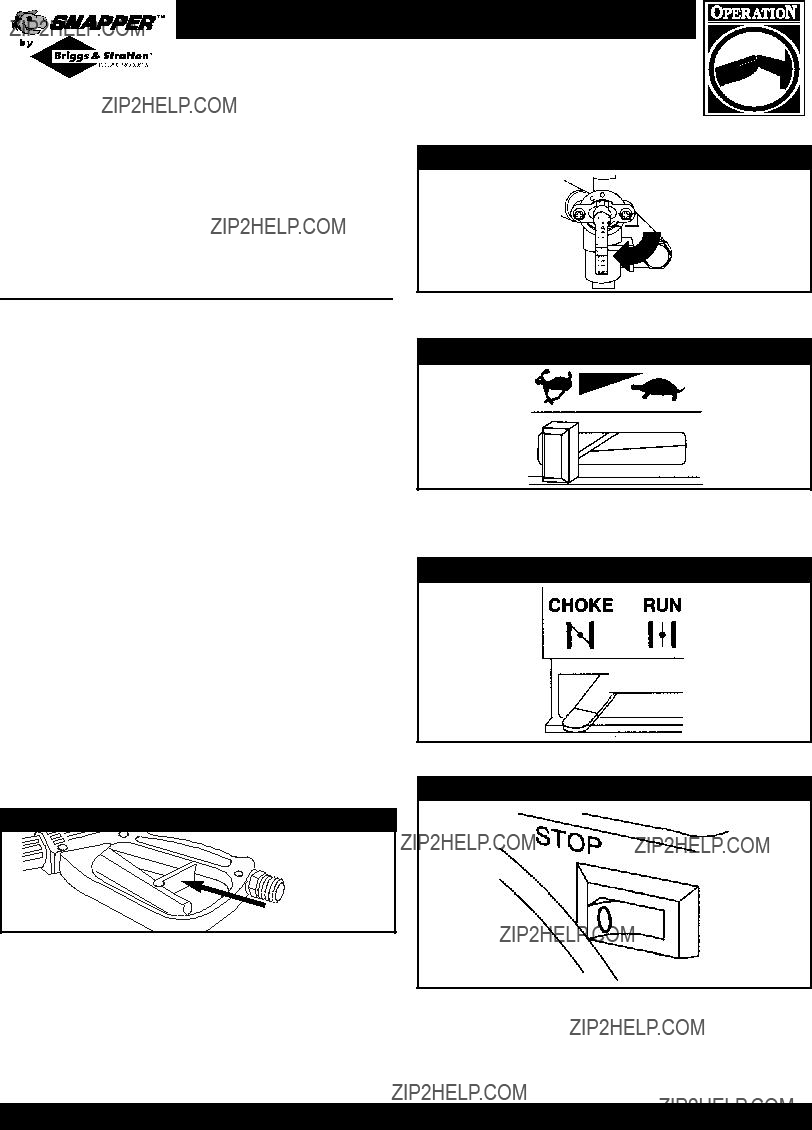
Snapper 3500 PSI Pressure Washer
HOW TO USE YOUR
PRESSURE WASHER
If you have any problems operating your pressure washer, please contact the local Snapper service center.
How to Start Your Engine
The best way to start your pressure washer for the first time is to follow these instructions
???Place the pressure washer in an area close enough to an outside water source that can flow at a rate of
3.9 gallons per minute or more.
???Make sure the unit is in a level position.
???Check that the high pressure hose is connected to the spray gun and to the pump. See ???Preparing Pressure Washer for Use??? on page 5.
???Connect the garden hose to the water inlet on the pressure washer pump and turn on the water.
CAUTION! Do Not run the pump without the water supply connected and turned on. You must follow this caution or the pump will be damaged.
???Squeeze the trigger on the spray gun to relieve the air pressure caused by turning ON the water. Water will discharge from the spray gun in a thin stream. Hold the trigger until a steady stream of water appears. This will make it easier to pull start the engine. Release the trigger.
???Apply the safety latch to the spray gun trigger (Figure 8).
Figure 8 ??? Spray Gun with Safety Latch Engaged
Safety Latch
??? Move the fuel valve to the ???On??? position (Figure 9).
Figure 9 ??? Fuel Valve
???Move the throttle lever to the ???Fast??? position, shown on engine as a rabbit (Figure 10).
Figure 10 ??? Throttle Positions
???To start a cold engine, move the choke lever to the ???Choke??? position. To restart a warm engine, leave the choke lever in the ???Run??? position (Figure 11).
Figure 11 ??? Choke Positions
???Set the rocker switch to the ???On??? position (Figure 12).
Figure 12 ??? Stop Switch
???Grasp starter grip and pull slowly until you feel some resistance. Then pull cord out with rapid full arm stroke. Let rope return slowly. Do Not let rope ???snap back??? against starter.
8

Snapper 3500 PSI Pressure Washer
???If the choke lever has been moved to the ???Choke??? position to start the engine, gradually move it to the ???Run??? position as the engine warms up.
???Attach the nozzle extension to the spray gun. Tighten by hand (Figure 13).
Figure 13 ??? Connect Nozzle Extension to Spray Gun
???Select the desired quick connect nozzle and insert it into the end of the nozzle extension (see ???How To Use the Nozzles???).
???Disengage the safety latch on the spray gun.
How to Stop Your Pressure Washer
???Move the throttle lever to the ???Slow??? position.
???Move the fuel valve to the ???Off??? position.
???Wait for the engine to idle down.
???Move the rocker switch to the ???Stop??? position.
???Simply shutting off the engine will not release pressure in the system. Squeeze trigger on the spray gun to relieve pressure in the hose.
How to Use the Nozzles
 CAUTION! Never exchange nozzles without locking the safety latch on the trigger.
CAUTION! Never exchange nozzles without locking the safety latch on the trigger.
The
Follow these instructions to change nozzles:
???Engage the safety latch on the spray gun.
???Pull back the collar on the
NOTE: For a more gentle rinse, select the white 40?? or green 25?? nozzle. To scour the surface, select the yellow 15?? or red 0?? nozzle. To apply chemical, select the black nozzle.
???Pull back on the collar, insert the new nozzle and release the collar. Tug on the nozzle to make sure it is securely in place.
???For most effective cleaning, keep the spray nozzle between 8 to 24 inches away from the cleaning surface. If you get the spray nozzle too close, you may damage the cleaning surface.
Use to apply chemical

Snapper 3500 PSI Pressure Washer
Cleaning and Applying Chemical
After you have applied detergent, scour the surface and rinse it clean as follows:
CAUTION! You must attach all hoses before you start the engine. Starting the engine without all the hoses connected and without the water turned ON will damage the pump.
IMPORTANT: Use soaps designed specifically for pressure washers. Household detergents could damage
the pump.
To apply detergent follow these steps:
???Review the use of the nozzles.
???Prepare the detergent solution as required by the manufacturer.
???Place the chemical injection siphon/filter into the detergent container.
CAUTION! Keep the chemical injection tube from coming in contact with the hot muffler.
??? Make sure the black nozzle is installed.
NOTE: Detergent cannot be applied with the high pressure nozzles (White, Green, Yellow, or Red).
???Make sure the garden hose is connected to the water inlet. Check that the high pressure hose is connected to the spray gun and the pump and start the engine.
???Apply the detergent to a dry surface, starting at lower portion of area to be washed and work upward, using long, even, overlapping strokes. Do Not allow the detergent to dry on (prevents streaking).
???Allow the detergent to soak in between
???Apply safety latch to spray gun.
???Remove the black chemical nozzle from the nozzle extension.
???Select and install the desired high pressure nozzle following the instructions ???How to Use the Nozzles??? on page 9.
???Keep the spray gun a safe distance from the area you plan to spray.
???Increase or decrease spray pressure by turning the pressure control knob counterclockwise or clockwise respectively (Figure 15). Use lower pressure to wash items such a as a car or boat. Use higher pressure to strip paint and degrease driveways.
Figure 15 ??? Pressure Control Knob
???Apply a high pressure spray to a small area and then check the surface for damage. If no damage is found, you can assume it is okay to continue cleaning.
???Start at the top of the area to be rinsed, working down with same overlapping strokes as you used for cleaning.
Automatic Cool Down System
Pressure Washer Rinsing
 WARNING! Be extremely careful if you must use the pressure washer from a ladder, scaffolding or any other relatively unstable location. Hose water pressure builds as you climb. When you press the trigger, the recoil from the initial spray can be very strong. The high pressure spray could cause you to fall if you are too close to the cleaning surface.
WARNING! Be extremely careful if you must use the pressure washer from a ladder, scaffolding or any other relatively unstable location. Hose water pressure builds as you climb. When you press the trigger, the recoil from the initial spray can be very strong. The high pressure spray could cause you to fall if you are too close to the cleaning surface.
(Thermal Relief)
If you run the engine on your pressure washer for
damage to the pump.
10
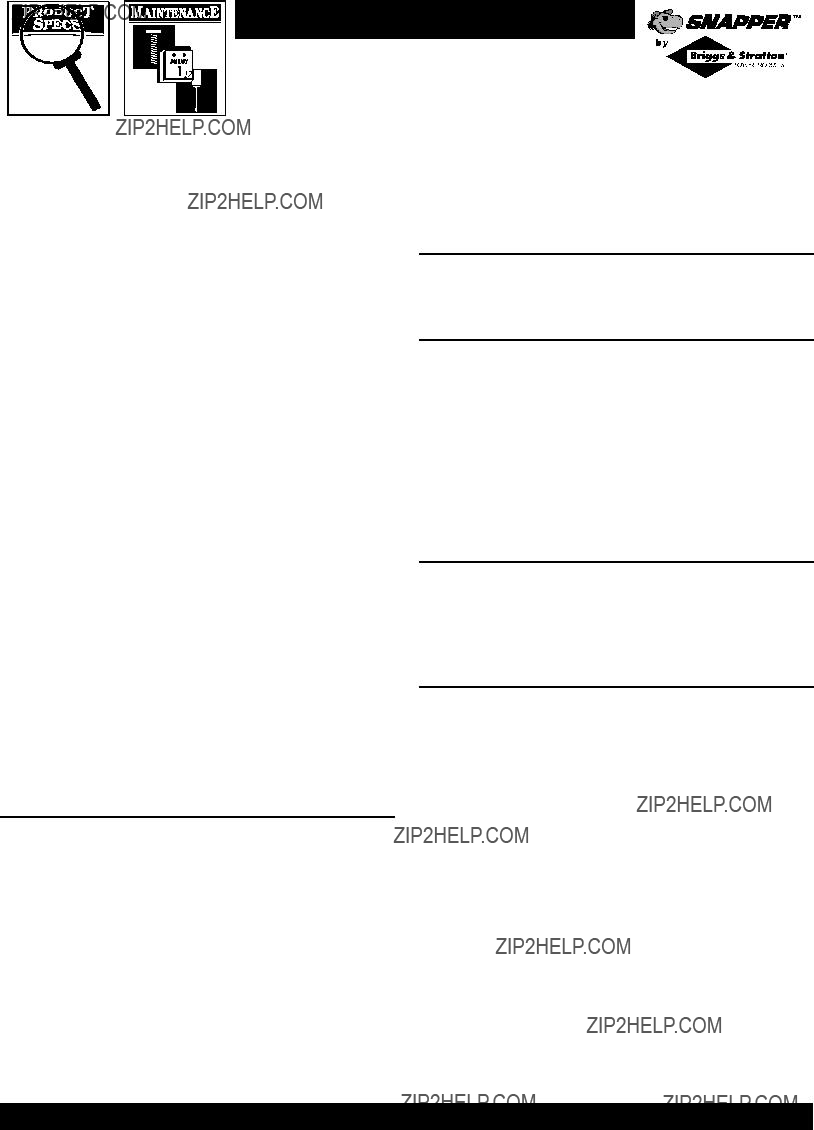
Snapper 3500 PSI Pressure Washer
SPECIFICATIONS
Rated Pressure . . . . . 3500 PSI
Flow Rate . . . . . . . . . . 3.5 gallons per minute (gpm)
Detergent . . . . . . . . . . Use detergent approved for pressure washers
Water Supply
Temperature . . . . . . . Not to exceed 100??F
Automatic Cool . . . . Will cycle when water
Down System reaches
Shipping Weight . . . . 155 lbs.
GENERAL MAINTENANCE
RECOMMENDATIONS
The pressure washer warranty does not cover items that have been subjected to operator abuse or negligence. To receive full value from the warranty, the operator must maintain the pressure washer as instructed in this manual.
???Some adjustments will need to be made periodically to properly maintain your pressure washer.
???All maintenance in this manual and the engine owner???s manual should be made at least once each season.
???Once a year you should clean or replace the spark plug, clean or replace the air filter and check the spray gun and nozzle extension assembly for wear. A new spark plug and clean air filter assure proper
BEFORE EACH USE
???Check engine oil level.
???Check water inlet screen for damage.
???Check
???Check high pressure hose for leaks.
???Check detergent siphoning tube and filter for damage.
???Check spray gun, nozzle extension, and nozzles for leaks.
???Rinse out garden hose to flush out debris.
PRESSURE WASHER
MAINTENANCE
Check and Clean Inlet Screen
Examine the screen on the water inlet. Clean it if the screen is clogged or replace it if screen is damaged.
Check High Pressure Hose
The high pressure hose can develop leaks from wear, kinking, or abuse. Inspect the hose each time before using it. Check for cuts, leaks, abrasions or bulging of cover, damage or movement of couplings. If any of these conditions exist, replace the hose immediately.
 WARNING! Never repair a high pressure hose. Replace it with another hose that exceeds the maximum pressure rating of your pressure washer.
WARNING! Never repair a high pressure hose. Replace it with another hose that exceeds the maximum pressure rating of your pressure washer.
Check Detergent Siphoning Tube
Examine the filter on the detergent tube and clean if clogged. The tube should fit tightly on the barbed fitting. Examine the tube for leaks or tears. Replace the filter or tube if either is damaged.
Cleaning Detergent Siphoning Tube
If you used the detergent siphoning tube, you must flush it with clean water before stopping the engine.
???Place the chemical injection siphon/filter in a bucket full of clean water.
???Attach the black low pressure nozzle.
???Flush for
???Shut off the engine.
IMPORTANT: Simply shutting OFF engine will not release pressure in the system. When the engine has shut down, squeeze the trigger on the spray gun to relieve the pressure in the hose.
11
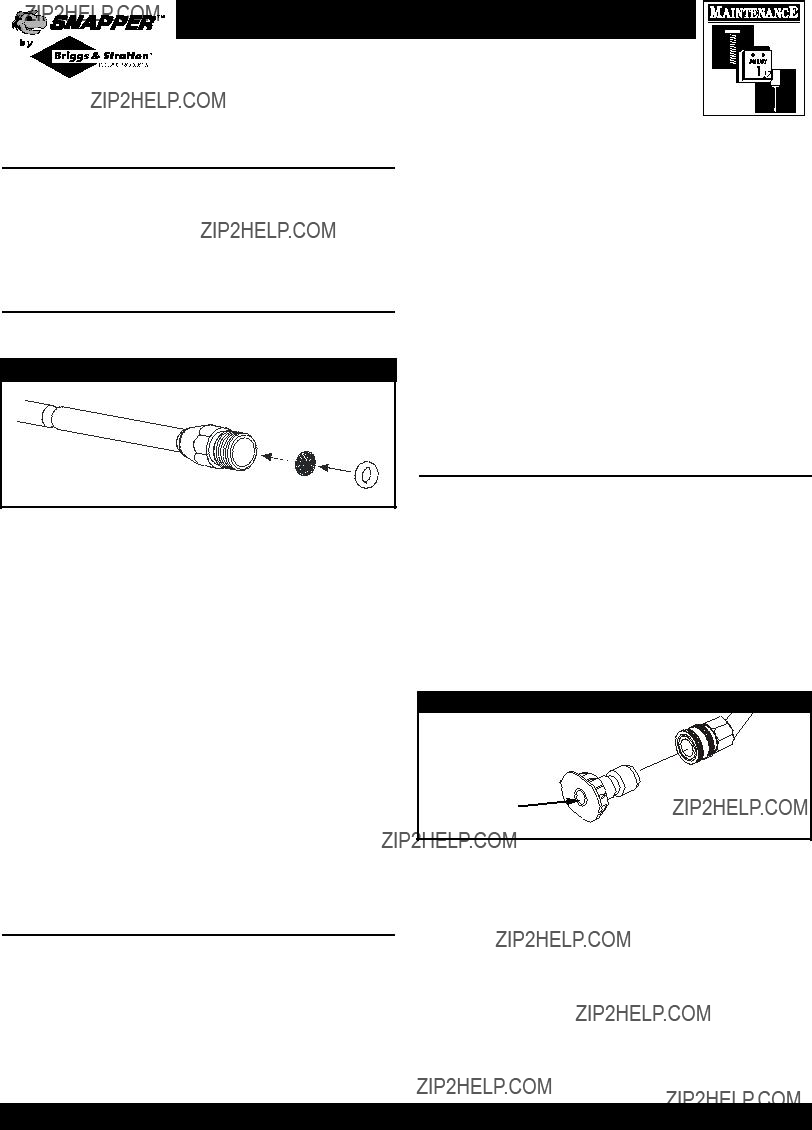
Snapper 3500 PSI Pressure Washer
Check Gun and Nozzle Extension
Examine the hose connection to the spray gun and make sure it is secure. Test the trigger by pressing it and making sure it springs back into place when you release it. Put the safety latch in the on position and test the trigger. You should not be able to press the trigger.
Check
Refer to Figure 16 and service the
Figure 16 ??? Clean
1.Detach spray gun and nozzle extension from high pressure hose. Detach nozzle extension from spray gun and remove
2.If the screen is damaged, the
3.Place the
4.Place the
5.Assemble the nozzle extension to the spray gun, as described earlier in this manual.
???When the water supply is steady and constant, engage the safety latch.
To remove contaminants from the pump, follow these steps:
???Set up the pressure washer as described in ???Preparing Pressure Washer For Use???. Connect the water supply and turn water on.
???Start the engine according to instructions in ???To Start Your Pressure Washer???.
???Remove nozzle extension from spray gun.
???Squeeze the trigger on the spray gun and hold.
???When the water supply is steady and constant, engage the safety latch and reattach the nozzle extension.
Nozzle Maintenance
A pulsing sensation felt while squeezing the spray gun trigger may be caused by excessive pump pressure. The principal cause of excessive pump pressure is a nozzle clogged or restricted with foreign materials, such as dirt, etc. To correct the problem, immediately clean the nozzle using the tools included with your pressure washer and follow these instructions:
1.Shut off the engine and turn off the water supply.
2.Remove the nozzle from the end of the nozzle extension (Figure 17).
Figure 17 ??? Nozzle Maintenance
Use wire here to remove debris.
3.Remove the
Purge Pump of Air and
Contaminants
To remove air from the pump, follow these steps:
???Set up the pressure washer as described in ???Preparing
Pressure Washer For Use???. Connect the water supply and turn water on.
???Pull the trigger on the spray gun and hold.
4.Use the wire included in the kit (or a small paper clip) to free any foreign material clogging or restricting the nozzle (Figure 17).
5.Using a garden hose, remove additional debris by back flushing water through the nozzle extension
(Figure 18). Back flush between 30 to 60 seconds.
12
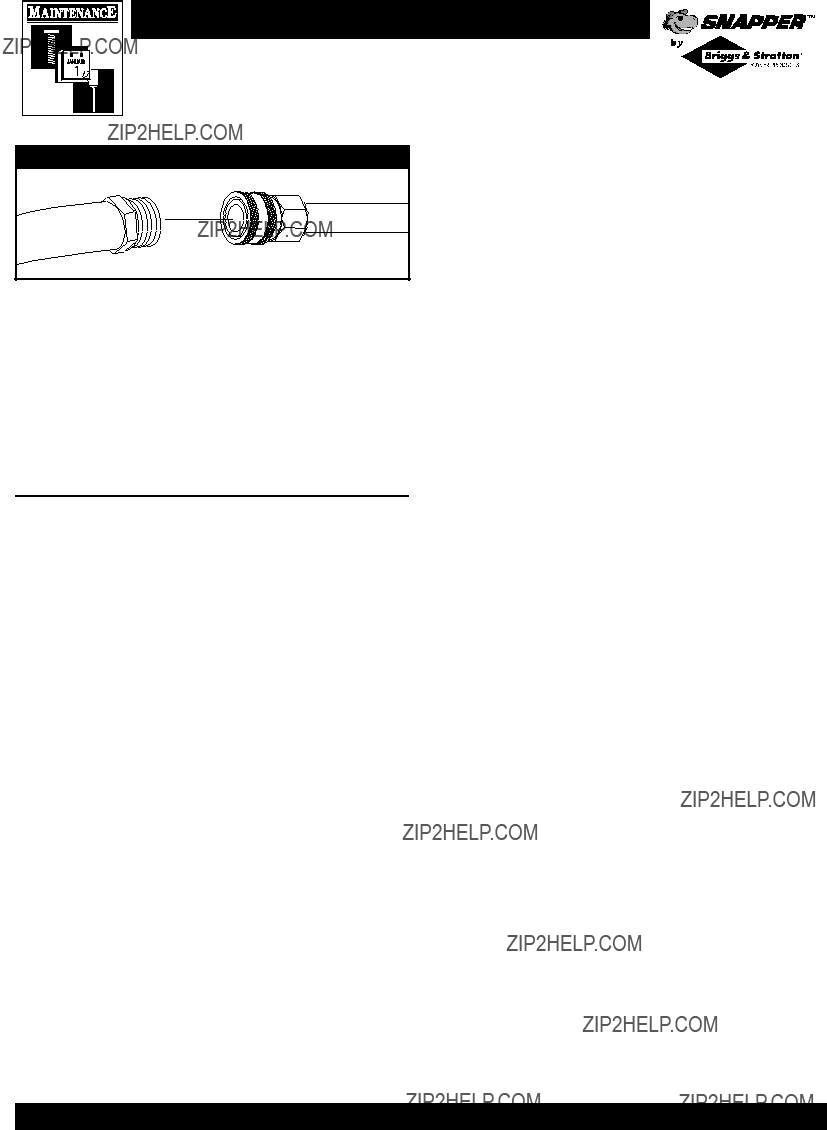
Snapper 3500 PSI Pressure Washer
Figure 18 ??? Backflushing the Nozzle Extension
6.Reinstall the nozzle and
7.Reconnect the nozzle extension to the spray gun.
8.Reconnect the water supply, turn on the water, and start the engine.
9.Test the pressure washer by operating with each of the Quick Connect nozzles.
Through the normal operation of your pressure washer,
An
To remove a worn or damaged
???Use a small flathead screwdriver to get underneath the
PREPARING THE UNIT
FOR STORAGE
Water should not remain in the unit for long periods of time. Sediments or minerals can deposit on pump parts and ???freeze??? pump action. If you do not plan to use the pressure washer for more than 30 days, follow this procedure:
1.Flush detergent siphoning tube by placing the filter into a pail of clean water while running pressure washer in low pressure mode. Flush for one to two minutes.
2.Shut off the engine and let it cool, then remove all hoses. Disconnect spark plug wire from spark plug.
3.Empty the pump of all pumped liquids by pulling the recoil handle about 6 times. This should remove most of the liquid in the pump.
4.Use PumpSaver to treat pump. This prevents freeze damage and lubricates pistons and seals.
NOTE: If PumpSaver is not available, draw RV antifreeze
5.Store unit in a clean, dry area.
STORING THE ENGINE
See the engine owner???s manual for instructions on how to properly prepare the engine for storage.
ENGINE MAINTENANCE
See the engine owner???s manual for instructions on how to properly maintain the engine.
 CAUTION! Avoid prolonged or repeated skin contact with used motor oil. Used motor oil has been shown to cause skin cancer in certain laboratory animals. Thoroughly wash exposed areas with soap and water. KEEP OUT OF REACH OF
CAUTION! Avoid prolonged or repeated skin contact with used motor oil. Used motor oil has been shown to cause skin cancer in certain laboratory animals. Thoroughly wash exposed areas with soap and water. KEEP OUT OF REACH OF
CHILDREN. DON'T POLLUTE. CONSERVE
RESOURCES. RETURN USED OIL TO
COLLECTION CENTERS.
13

Snapper 3500 PSI Pressure Washer
NOTES
14

Snapper 3500 PSI Pressure Washer
TROUBLESHOOTING
15
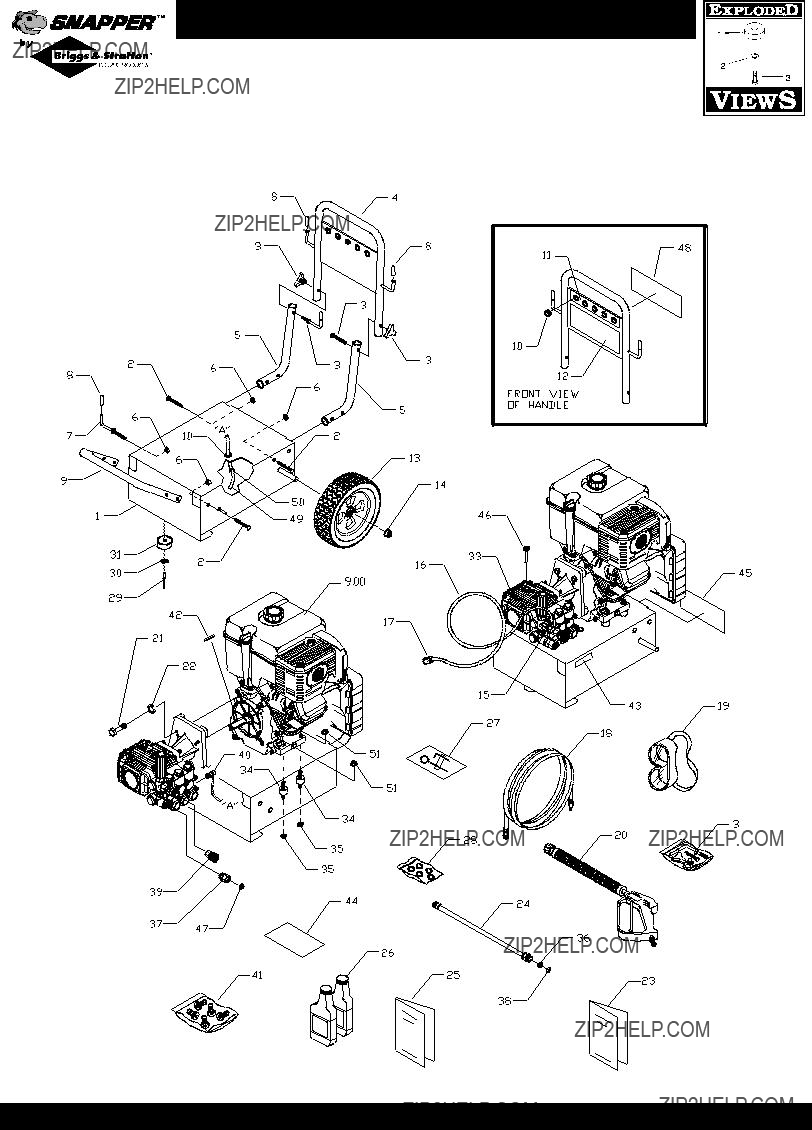
Snapper 3500 PSI Pressure Washer
EXPLODED VIEW ??? UNIT
16
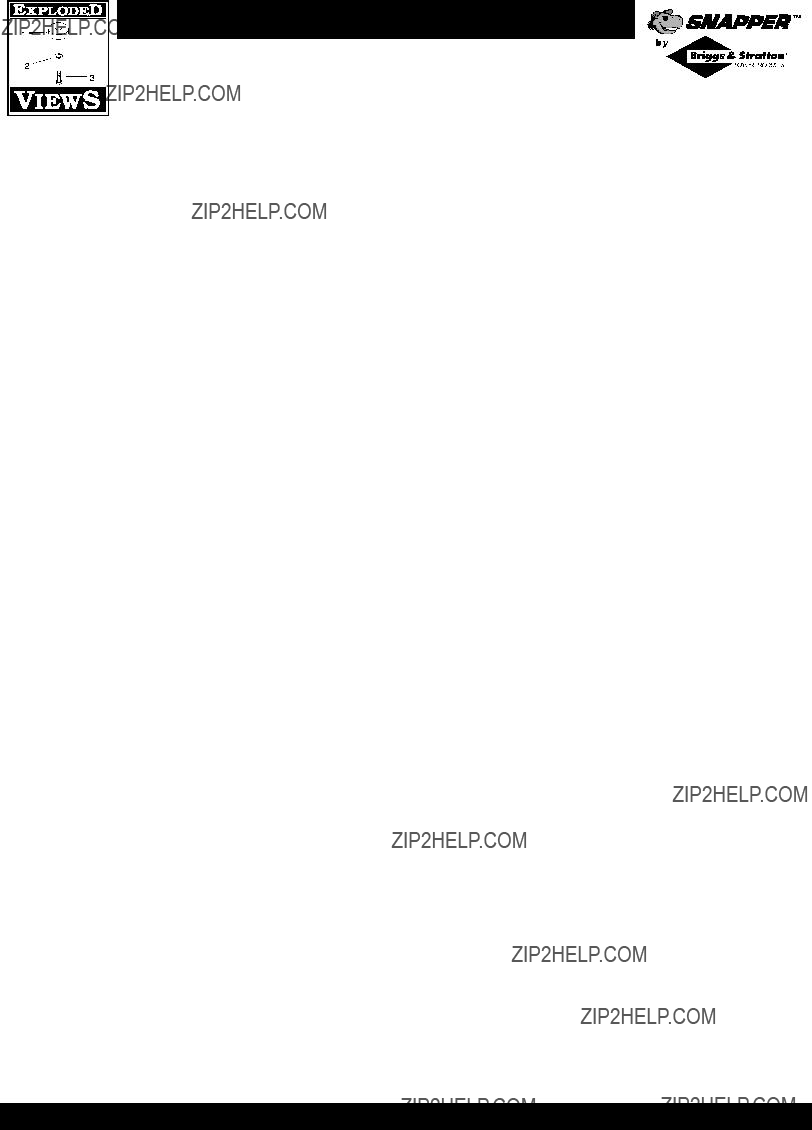
Snapper 3500 PSI Pressure Washer
PARTS LIST ??? UNIT
17

Snapper 3500 PSI Pressure Washer
EXPLODED VIEW ??? PUMP
18
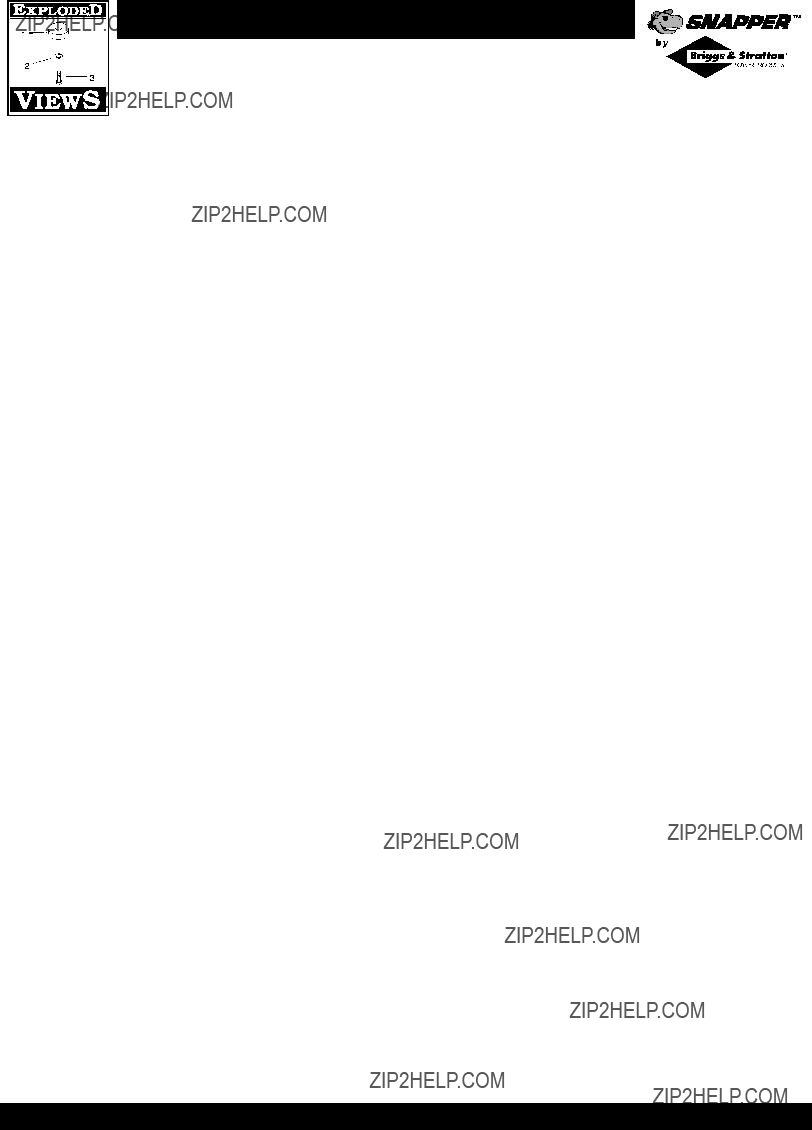
Snapper 3500 PSI Pressure Washer
PARTS LIST ??? PUMP
19
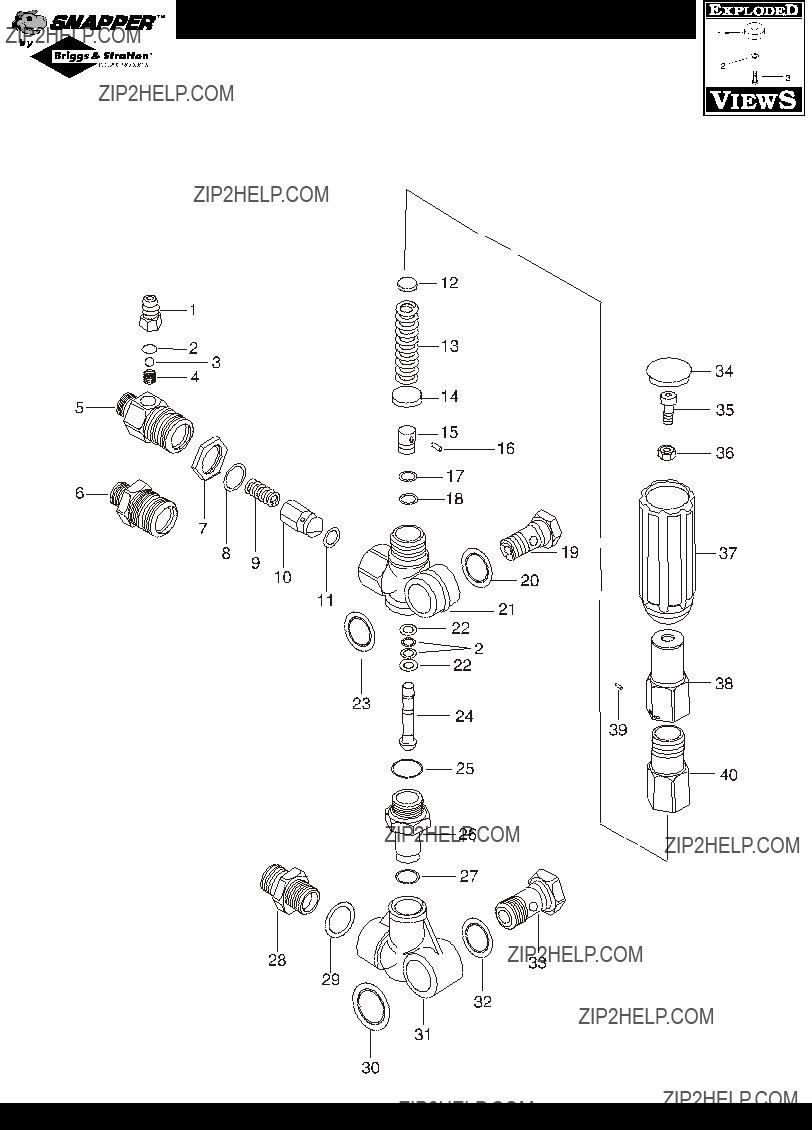
Snapper 3500 PSI Pressure Washer
EXPLODED VIEW ??? UNLOADER
20

Snapper 3500 PSI Pressure Washer
PARTS LIST ??? UNLOADER
21
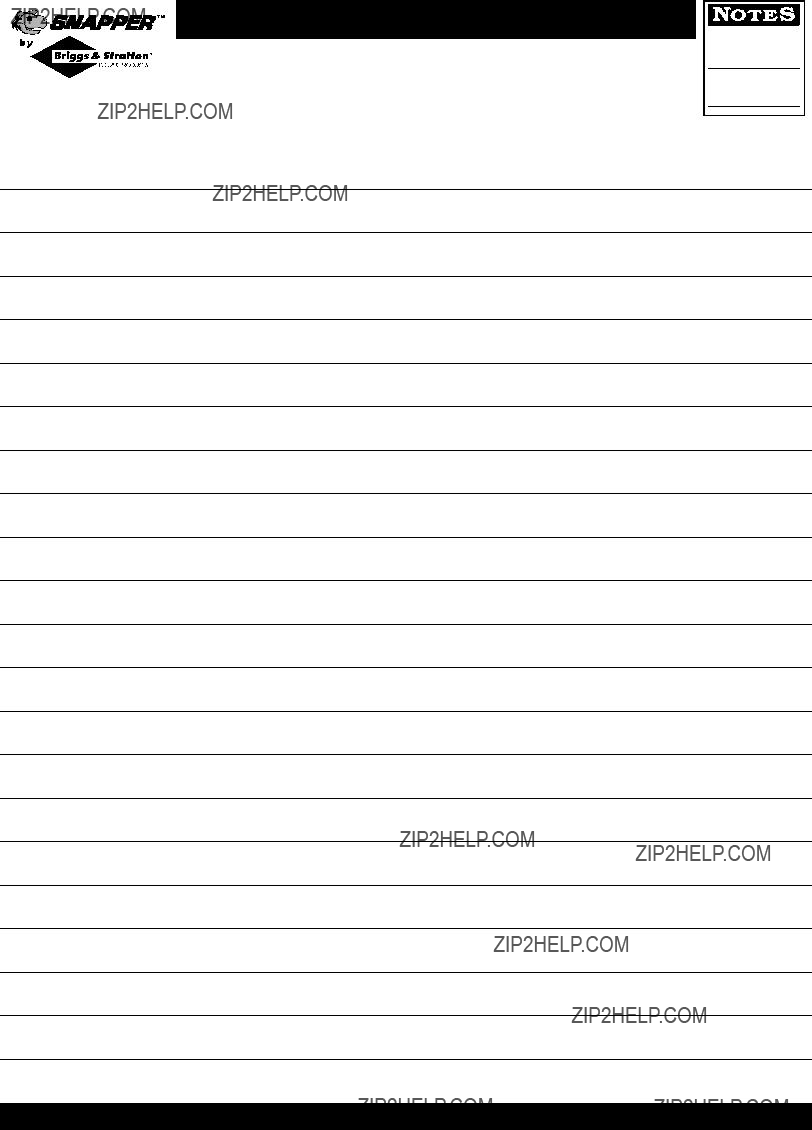
Snapper 3500 PSI Pressure Washer
NOTES
22

Snapper 3500 PSI Pressure Washer
NOTES
23
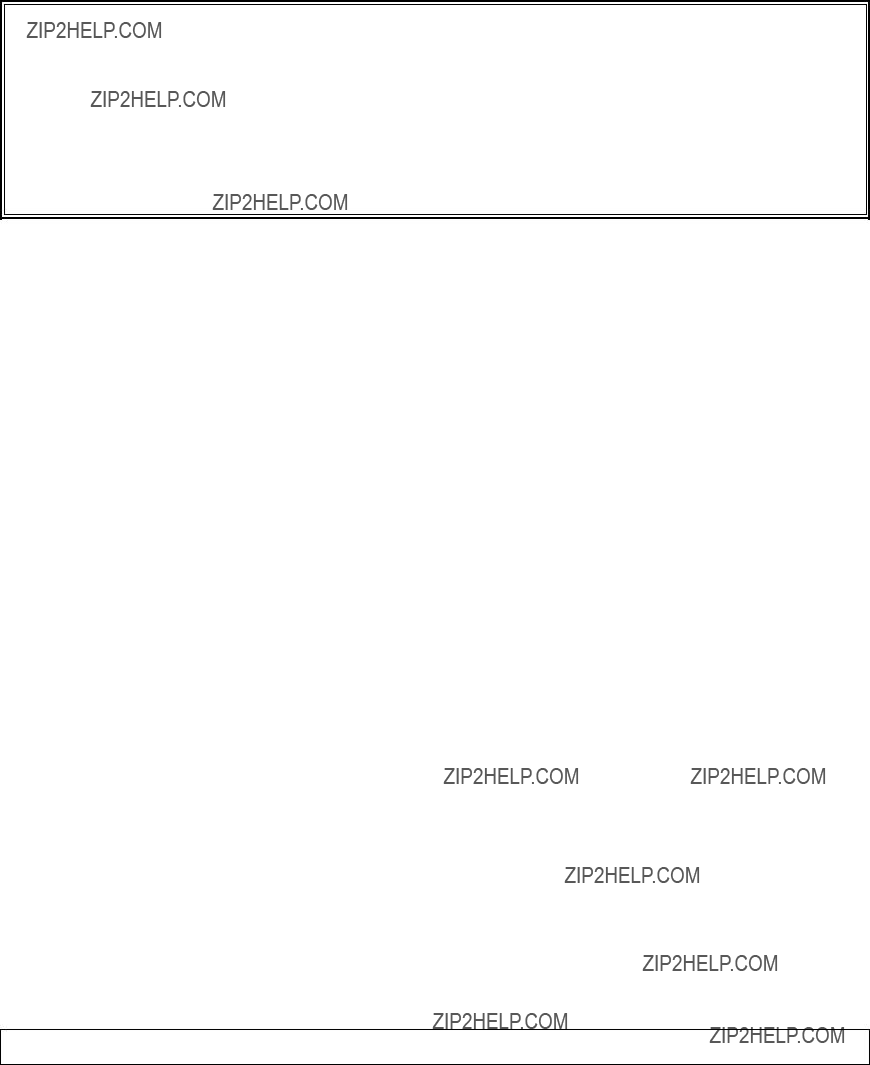
LIMITED WARRANTY
SNAPPER??? OWNER WARRANTY POLICY Effective October 1, 2001
LIMITED WARRANTY
???This Snapper??? product is distributed under license by Generac Portable Products, LLC, a subsidiary of Briggs & Stratton. Generac Portable Products LLC will repair or replace, free of charge, any part, or parts of the equipment that are defective in material or workmanship or both. Transportation charges on parts submitted for repair or replacement under this Warranty must be borne by purchaser. This warranty is effective for the time periods and subject to the conditions provided for in this policy. For warranty service, find the nearest Authorized Service Dealer in our dealer locator map at
RANTIES, INCLUDING THOSE OF MERCHANTABILITY AND FITNESS FOR A PARTICULAR PURPOSE, ARE LIMITED TO THE TIME
PERIOD SPECIFIED, OR TO THE EXTENT PERMITTED BY LAW ANY AND ALL IMPLIED WARRANTIES ARE EXCLUDED. LIABILITY FOR
CONSEQUENTIAL DAMAGES UNDER ANY AND ALL WARRANTIES ARE EXCLUDED TO THE EXTENT EXCLUSION IS PERMITTED BY LAW. Some states do not allow limitations on how long an implied warranty lasts, and some states do not allow the exclusion or limitation of incidental or consequential damages, so the above limitation and exclusion may not apply to you. This warranty gives you specific legal rights and you may also have other rights which vary from state to state and country to country."
WARRANTY PERIOD*
*The warranty period begins on the date of purchase by the first retail consumer or commercial end user, and continues for the period of time stated in the table above. "Consumer use" means personal residential household use by a retail consumer. "Commercial use" means all other uses, including use for commercial, income producing or rental purposes. Once equipment has been used commercially, it shall thereafter be considered to be in commercial use for purposes of this warranty. Used equipment, demonstration equipment and equipment used for prime power in place of a utility are not warranted. Accessory parts such as guns, hoses, wands and nozzles are excluded from the product warranty.
**The gasoline engine and starting batteries are warranted solely by the manufacturers of those products.
WARRANTY REGISTRATION IS NOT NECESSARY TO OBTAIN WARRANTY ON GENERAC PORTABLE PRODUCTS
EQUIPMENT. SAVE YOUR PROOF OF PURCHASE RECEIPT. IF YOU DO NOT PROVIDE PROOF OF THE INITIAL
PURCHASE DATE AT THE TIME WARRANTY SERVICE IS REQUESTED, THE MANUFACTURING DATE OF THE
EQUIPMENT WILL BE USED TO DETERMINE THE WARRANTY PERIOD.
About your equipment warranty:
Generac Portable Products welcomes warranty repair and apologizes to you for being inconvenienced. Any Authorized Service Dealer may perform warranty repairs. Most warranty repairs are handled routinely, but sometimes requests for warranty service may not be appropriate. For example, warranty would not apply if equipment damage occurred because of misuse, lack of routine maintenance, shipping, handling, warehousing or improper installation. Similarly, warranty is void if the serial number of the equipment has been removed or the equipment has been altered or modified.
If a customer differs with the decision of the Service Dealer, an investigation will be made to determine whether the warranty applies. Ask the Service Dealer to submit all supporting facts to its Distributor for review. If the Distributor decides that the claim is justified, the customer will be fully reimbursed for those items that are defective. To avoid misunderstandings that might occur between the customer and the Dealer, listed below are some of the causes of equipment failure that the warranty does not cover:
Normal wear:
Outdoor Power Equipment, like all mechanical devices, needs periodic parts, service and replacement to perform well. This warranty does not cover repair when normal use has exhausted the life of a part or the equipment.
Installation and Maintenance:
This warranty does not apply to equipment or parts that have been subjected to improper or unauthorized installation or alteration, misuse, negligence, accident, overloading, overspeeding, improper maintenance, repair or storage so as, in Generac Portable Products' judgment, to adversely affect its performance and reliability. This warranty also does not cover normal maintenance such as adjustments, fuel system cleaning and obstruction (due to chemical, dirt, carbon or lime, etc.).
Other Exclusions:
Also excluded from this warranty are wear items such as quick couplers, oil gauges, belts,
Warranty is available only through service dealers authorized by Generac Portable Products. This warranty does not apply to service by any other entity.
To locate your nearest authorized Generac Portable Products Service Dealer, look at our dealer locator map on
Generac Portable Products Are Made Under One Or More Of The Following Patents: (Other Patents Pending)
Generac Portable Products, LLC
Jefferson, Wisconsin U.S.A.